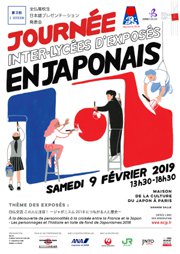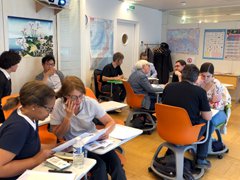Supporting Japanese Learning According to Situation and Need
The Japan Cultural Institute in Paris
KONDO Yumiko, MITSUYA Mayumi
The Japan Cultural Institute in Paris (hereinafter “Institute”) engages in a wide variety of Japanese language programs, but in this report I would like to focus on support for Japanese language learning in particular. (Please also refer to the reports from previous years.)
1. “Interschool Presentation Day”
Have You Heard of Any of These Names Below?
[FUJITA Tsuguharu, INABATA Katsutaro, Emile Guimet, YAMATA Kikou, NAKAE Chomin, OKAMOTO Taro, MIYAMOTO Shigeru].

A poster for the conference.(An image showing collaboration between Japanese and French high school students)
These were the famous individuals spoken of by the teams competing in the “3rd Interschool Presentation Day (All-France High School Japanese Presentation Competitioneld in February 2019. This was an official event for Japonismes 2018 in which high school students studying Japanese at four schools in France and guest high school students in Japan from three schools (two via video) formed teams of two to three members to give 10 to 15 minute presentations on the theme, “Discovering Japan-France Exchange through People, Their Lives, and Their Works: The role of the Individual in History leading to Japonismes 2018.
While there are many opportunities for learners to present their achievements in Japanese studies throughout the world, such as Japanese speech contests, this event was slightly different. The purpose of the event was not to compete and be evaluated according to their Japanese language ability. Instead, each team cooperated to gather information on a famous person that served as a bridge between Japan and France and analyze critically their lifestyles and the influence they had on later generations, including the students themselves, and then compile their findings in a presentation. Accordingly, the process itself was an opportunity for learning, and the presentation conference was an opportunity to share their results.
Giving a presentation in a hall that can hold over 300 people was a first and a major challenge for the high school students. In order to support the students in that challenge, the Japanese-language education program of the Institute provides them with supports during the preparations or for their learning processes including giving documentation for choosing who to speak about, preparing the presentation materials, and teaching presentation methods. We also set aside time for round-table discussions between the participants on the stage after the presentations are finished, and a reception after the event in order to make it serve as the opportunity for the students to interact with each other. We also make an effort to enable those attending the conference to participate themselves in a variety of ways, such as interacting with the commentators and providing feedback using sticky notes.
In this way, an important part of the job of the Advisor is to go beyond Japanese studies in the classroom to help build networks of the next generation of people familiar with Japan and plan opportunities for them to connect with each other through the Japanese language.
2. Constant Change in Japanese-Language Education and the Japanese-Language Course
The Institute’s Japanese-language course began in 2011 as a monitor course using the “Marugoto: Japanese Language and Culture” (hereinafter “Marugoto”) learning materials. At the time there were only two classes with a total of 18 students. In the eight years since then, the course has expanded to cover Starter (A1) through Intermediate (B1), and the number of students has grown to a number that exceeds 250 at times.

The bridge class
Meanwhile, looking at the trends for Japanese-language education, major changes are occurring to the learning environment for students for these years. Perhaps the greatest of those changes is that the place where students learn has expanded from the classroom to the world of the Internet, due in part to the diversification of motivations to learn Japanese. While in the past, the majority of new learners at the Institute were those with no prior experience with Japanese, the number who have already touched on Japanese studies via the Internet has been increasing in recent years. Accordingly, the Institute is working on a new initiative for the Japanese-language course to keep pace with these changing times. One such initiative is a shift of the emphasis of the course from Starter (A1) and Elementary (A2) to Elementary (A2)/Intermediate (B1) and above. The launch of the Marugoto Online Course via the JF Japanese e-learning Minato platform developed by the Japan Foundation has made it relatively easy to learn at the Elementary level. Accordingly, the Starter(A1) through Elementary(A2) will primarily shift to the online platform moving forward, allowing us to add more learning options at the levels of Elementary(A2)/Intermediate(B1) and above. As the first step towards realizing that shift, we are currently implementing a bridge class from Elementary (A2)/Intermediate (B1) to Intermediate (B1). When I observe the students who have progressed from the Starter (A1) level using Marugoto, I sense that while they can complete specific “can-do” tasks (task-oriented based activities), the overall capabilities they should possess by now beyond the individual can-do tasks are still inadequate. It therefore occurred to me that it was necessary for them to take what they had learned through the can-do tasks and relearn it in a different context to understand it systematically. I also felt it was necessary for them to gradually acquire the strategizing abilities required for a smooth transition to Intermediate (B1) at the same time. The class currently covers subjects including speed reading, shadowing, role playing, reading comprehension, and Kanji, which can be combined in various ways.
In the near future, more students will likely join the course after having studied up to the Elementary (A2) at another educational institutions or schools. With that degree of diversification among the students, my hope is that diversity itself will become one of the appeals of the Japanese-language course at the Institute.
- What We Do Top
- Arts and Cultural Exchange [Culture]
- Japanese-Language Education Overseas [Language]
- Japanese-Language Education Overseas [Language] Top
- Learn Japanese-language
- Teach Japanese-language
- Take Japanese-Language Test
- Know about Japanese-language education abroad
- The Japanese-Language Institute, Urawa
- The Japanese-Language Institute, Kansai
- Japanese-Language Programs for Foreign Specified Skilled Worker Candidates
- Japanese Language Education for Japanese Children Resident Overseas and for the Descendants of Migrants
- Archives
- Japanese Studies and Global Partnerships [Dialogue]
- JF digital collection
- Other Programs / Programs to Commemorate Exchange Year
- Awards and Prizes
- Publications
